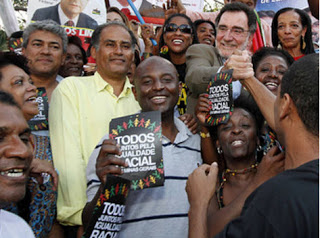This Article First Appeared on: blackbraziltoday.com
Written By: Marques Travae
Buying power of Brazil’s black population now over R$673 (US$336) billion a year
Group is more optimistic about the increase in income in future years
Claudio Martins of Mundo do Marketing
A survey indicated an increase of blacks among the members of Brazil’s class C* economic strata, which increased from 34% in 2004 to 45% in 2009.
* – For an understanding of Brazil’s socioeconomic standards, please see bottom of page
Rio de Janeiro – The black population in Brazil is responsible for R$673 billion in spending per year according to a study by the Popular Data group which was commissioned by the Baobab Fund. Between 2004 and 2011, there was an increase of the group, which totaled 48.3% of the population and now account for 51.7%.
The survey indicates an increase of blacks among the members of the class C economic group, which increased from 34% in 2004 to 45% in 2009. At the top of the economic pyramid, the expansion of the black population was 4% in the class A economic group, while in class E, one of the poorest economic groups, there was a reduction from 7% to 2% in the period.
Among the consumer goods that the black population had more access to were washing machines, which grew from 19.9% in 2004 to 30.6% in 2009, and computers, with an increase of 8% to 24.5% in the period. The purchase of televisions (93.4%), refrigerators (90%), radio (84.7%) and stoves (97.7%) showed little change.
A total of 67.6% of the black population is more optimistic about the growth of their income, while the group considered non-black, the expectation is 60.5%. Only 20% of black Brazilians have a car and among the rest of the population that do not consider themselves black, car ownership reaches 41%. The most utilized form of payment for vehicles being used by this population is the bank financing (38.3%), followed closely by cash payment (32.7%), funding offered by auto dealers (15.7%) and installment credit (7.7%).
Brazil’s socioeconomic class standards
The economic class structure in Brazil is somewhat similar to how classes are grouped in the United States with the letters A through F defining each economic group. Classes A through C represent the upper, upper-middle and middle classes respectively. Class D is considered the working class with classes E and F representing the poor and extremely poor classes. In terms of income, here is how the economic groups can be broken down.
Class A1: Families having a monthly income of more than R$14,400
Class A2: Families having a monthly income of more than R$8,100
Class B1: Families having a monthly income of more than R$4,600
Class B2: Families having a monthly income of more than R$2,300
Class C1: Families having a monthly income of more than R$1,400
Class C2: Families having a monthly income of more than R$950
Class D: Families having a monthly income of more than R$600
Class E: Families having a monthly income of more than R$400
Class F: Families having a monthly income of less than R$200
The monthly income is based on Brazil’s currency, the Real (plural Reais) represented by the letter R. When the Real debuted in its current configuration in the 1990s, its value was pegged to the American Dollar and like any currency, its value fluctuates on the world market. As of May 25th, 2012, one American Dollar was worth about two Brazilian Reais. Thus, to attain value in Dollars, all of the above totals should be cut in half. With this in mind, it is important to understand that what constitutes lower middle class status in Brazil wouldn’t equal the same in the US. For example, to be considered lower middle class in Brazil, a family would need to earn between R$950 to R$1,400 Brazilian Reais per month which would equal approximately $475-700 American Dollars per month. In the US, families that are considered to be part of the lower class earn $15,000 American Dollars per year or $1,250 per month.

